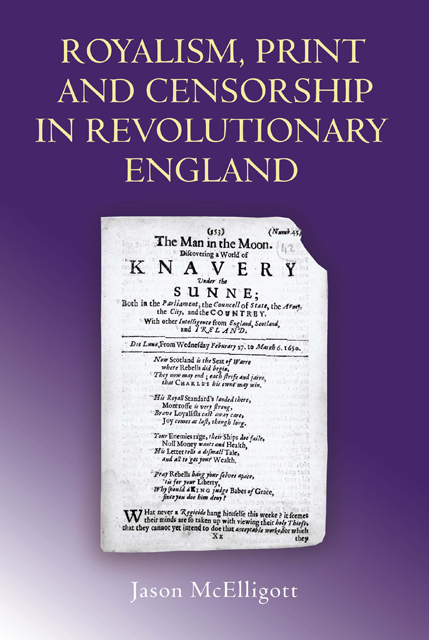Book contents
- Frontmatter
- Contents
- Illustrations
- Acknowledgements
- Abbreviations
- Introduction: Royalism and its Problems
- 1 Royalists and Polemic in the 1640s
- 2 The Politics of Sexual Libel
- 3 The Twists and Turns of Royalist Propaganda
- 4 Authors, Shifting Allegiances and the Nature of Royalism
- 5 Printers, Publishers and the Royalist Underground
- 6 Hunting the Royalist Press
- 7 The Theory and Practice of Censorship
- 8 A New Model of Press Censorship
- Conclusion
- Select Bibliography
- Index
1 - Royalists and Polemic in the 1640s
Published online by Cambridge University Press: 10 March 2023
- Frontmatter
- Contents
- Illustrations
- Acknowledgements
- Abbreviations
- Introduction: Royalism and its Problems
- 1 Royalists and Polemic in the 1640s
- 2 The Politics of Sexual Libel
- 3 The Twists and Turns of Royalist Propaganda
- 4 Authors, Shifting Allegiances and the Nature of Royalism
- 5 Printers, Publishers and the Royalist Underground
- 6 Hunting the Royalist Press
- 7 The Theory and Practice of Censorship
- 8 A New Model of Press Censorship
- Conclusion
- Select Bibliography
- Index
Summary
The development of royalist propaganda
Charles I has traditionally been seen as a proud, haughty and aloof man unconcerned with the need to court public opinion. He has often been portrayed, both consciously and unconsciously, as an arrogant, foppish snob, a devotee of courtly masques, fawning verse, extravagant architecture and opulent art who thumbed his nose at the increasingly obvious need to use the printing press to explain his controversial policies to his subjects during the first decade and a half of his reign. It is somewhat surprising that both his admirers and detractors have fashioned such broadly similar images of the king, although they have of course differed as to whether his interests, preoccupations and personality should be commended or condemned. In recent years we have come to realize that this image of Charles's relationship with his subjects is a caricature, a skilfully created image which captures something of the truth but distorts it beyond all reason while ignoring other important facets of his character. It is certainly true that Charles was personally shy and that, like many people in this situation, he sometimes seemed to others to be rude, arrogant or disagreeable. It is also true that he was a connoisseur of the finer things in life and that he enjoyed the process of buying and amassing an admirable collection of art. It is also undeniable that these interests created a great deal of suspicion among the ‘hotter sort’ of Charles's subjects.
It would, however, be inaccurate to claim that Charles did not understand the need to appeal to his people. Even during the Personal Rule, the eleven-year period when Charles was supposedly at his most removed from his subjects, the king regularly communicated with the political nation by long-established modes of communication such as royal proclamations and the ‘tuning of the pulpits’ by the prescription of prayers and homilies in the 10,000 or so parish churches throughout England and Wales. It is also necessary to note that on a number of occasions during the first three or four years of his reign Charles did explain a number of his policies in print.
- Type
- Chapter
- Information
- Royalism, Print and Censorship in Revolutionary England , pp. 13 - 44Publisher: Boydell & BrewerPrint publication year: 2007

